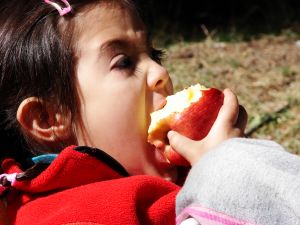By Rita Brhel, managing editor and attachment parenting resource leader (API)
 Attachment Parenting International’s Eight Principles of Parenting calls parents to feed their children with love and respect. With infants, this easily translates into breastfeeding or “bottle nursing.”
Attachment Parenting International’s Eight Principles of Parenting calls parents to feed their children with love and respect. With infants, this easily translates into breastfeeding or “bottle nursing.”
But what does this mean once children transition to solid foods? How do parents continue AP as their children grow?
An Act of Love
First, parents need to remember that providing food to their children, no matter the age, is an act of love and a way to strengthen their emotional bond. By feeding them, parents are fulfilling a vital physical need. When children’s needs are met, they feel closer to their parents. This doesn’t change as babies grow into toddlers and toddlers into older children.
More than simply offering food, parents reveal how much they care for their children by offering healthy foods and modeling healthy food selection. This may mean that parents, themselves, have to change their eating habits, which can be difficult. This may also mean disagreements between parents and their children as they grow and are exposed to more models of unhealthy habits, especially as teens when peer influence begins to compete with the parental attachment.
Not Always Easy, But Worth the Work
Feeding with love and respect may seem to be one of the easier Attachment Parenting tools offered by Attachment Parenting International – that is, until the first time a weaned toddler decides to refuse all solid foods offered, except graham crackers, for a week. It’s the first sign of independence in the feeding department, and it can make parents worry about whether their child is getting all the nutrients he needs to thrive.
The advice for these parents, in dealing with challenges in feeding their children, is to explore strategies that are attachment-friendly. Forcing a child to eat a food she doesn’t want to eat doesn’t promote attachment; encouraging her to be a picky eater by not offering a variety of foods is unhealthy. Parents often have to be creative in coming up with AP solutions and may have to try several ideas before finding one or a couple that work.
Be Creative in Problem-Solving
It’s important to remember that one size does not fit all, and what may work for one parent may not work for another. Some parents say to simply not worry about a picky eater, that the child is eating as much as he needs and will eat more if he needs to; others find that if they don’t encourage their child to eat more foods that she consistently refuses to try new foods. Some parents trust their teens to make healthy food choices when they’re with their friends; other parents find that talking to their teens about the potential medical consequences of unhealthy food choices what works best.
No one knows a child, and what strategies will work to encourage healthy eating, better than her parent.
The advice for these parents, in dealing with challenges in feeding their children, is to explore strategies that are attachment-friendly.